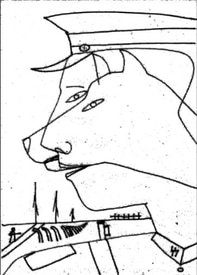Calamities > Holocaust
Holocaust
Destruction of European Jewry
|
In 1933, the Jewish population of Europe stood at over 9.5 million.
Europe was a home for 60 percent of all Jews. Most European Jews lived in countries that Nazi Germany would occupy or influence during World War II. In 1950, the Jewish population of Europe decreased to about 3.5 million. Continue
By 1945, the Germans and their collaborators killed nearly two out of every three
European Jews as part of the "Final Solution" the Nazi policy to murder the Jews of Europe. Of the 6 million or so Jews killed, roughly 3 million were pre-war Polish citizens, and another 2 million or so pre-war Soviet citizens residing in Ukraine, Belorussia, Lithuania, Russia, Latvia that taken together, 83 percent of the total. After the Polish and Soviet Jews, the next-largest groups of Jews killed were Romanian, Hungarian, and Czechoslovak. If these people are considered, the East European character of the Holocaust becomes even clearer. |
Holocaust by Bullets in USSR
The Nazis conducted the majority of the genocide by deporting Jews to death camps, located mostly in Poland. In the Soviet Union, however, the murder was local. Because of the region’s inadequate railway systems and the capacities of the death camps, the
Nazis were unable to easily transport the Jews to the camps. Instead, mobile execution units, like the Einsatzgruppen, gathered, shot and killed the Jews on their home soil.
Nazis were unable to easily transport the Jews to the camps. Instead, mobile execution units, like the Einsatzgruppen, gathered, shot and killed the Jews on their home soil.
Continue
Villages became execution sites and villagers became witnesses. After the executions, the Nazis buried their victims in mass ditches and continued on to another village. With bodies and bullets beneath the ground, the perpetrators left behind little indication of what had occurred. Paul A. Shapiro, Director of the Center for Advanced Holocaust Studies at the U.S. Holocaust Memorial Museum in Washington painted grim picture of the Holocaust by Bullets:
“The first mass victims of Holocaust were not transported in crowded cattle cart to secluded sites far from their homes. These victims - mostly woman, children, and old people – were taken from their homes, on foot or by cart or truck, to locations just outside of the towns and villages where they lived, if even that far.
There they were shot, usually the same day or hour, at close range, face to face, or in the back, one human killing another, and all in the presence of the local residence, the victims’ non-Jewish neighbors, even friends.”
Unlike Poland and Germany, where the Holocaust remains visible through the searing symbols of the extermination camps, the horror in Ukraine, Belarus and other Soviet republics was hidden away, first by the Nazis, then by the Soviets.
“The first mass victims of Holocaust were not transported in crowded cattle cart to secluded sites far from their homes. These victims - mostly woman, children, and old people – were taken from their homes, on foot or by cart or truck, to locations just outside of the towns and villages where they lived, if even that far.
There they were shot, usually the same day or hour, at close range, face to face, or in the back, one human killing another, and all in the presence of the local residence, the victims’ non-Jewish neighbors, even friends.”
Unlike Poland and Germany, where the Holocaust remains visible through the searing symbols of the extermination camps, the horror in Ukraine, Belarus and other Soviet republics was hidden away, first by the Nazis, then by the Soviets.
Holocaust Killing sites
Most comprehensive information about Holocaust killing sites in Eastern Europe is provided currently by Yad Vashem and Yahad-In Unum. Each organization has its unique approach to methods of collection information and its presentation.
Continue
Yad Vashem Holocaust Center holds largest amount of information about locations of Holocaust killing sites in Former Soviet Union. As of summer 2014 the Yad Vashem database of murder sites and mass executions of Jews in the FSU has registered 2,387 murder sites*. In comparison, Yahad-in Unum database covers 930 killing sites, or about 3 times less. However, scope of information and its sourcing are very different. Yahad-in Unum database provides rich visual content including testimonies witnesses, photos and video recording. The information was gathered, in most cases, by visiting killing sites and by interviewing local residents. Those expedition was started in 2004 by French Catholic priest Patrick Desbois. Yad Vashem, on other hand, started collecting and organizing Holocaust information after the war. Information was provided by Holocaust witnesses, survivors and victims’ relatives. In addition, wealth of information was extracted from German and, later, Soviet Union archives. Legacy of Yad Vashem Collection dictated prevalence of text narrative on its webpages.
Ukraine
Holocaust by Bullets
Killing Sites
Personal Stories
Jewish Resistance
Holocaust by Bullets
Killing Sites
Personal Stories
Letters:
Vera Orhelepova (Simpheropol)
Maria Boyko (Krasnostav)
Deresh (Izyaslav).
Stories:
Kogan-Rabinovich family story
Books:
Donna Rubinstein
Films:
The road to Krasnostav
Unknown Holocaust
Vera Orhelepova (Simpheropol)
Maria Boyko (Krasnostav)
Deresh (Izyaslav).
Stories:
Kogan-Rabinovich family story
Books:
Donna Rubinstein
Films:
The road to Krasnostav
Unknown Holocaust
Jewish Resistance
Names of Holocaust victims
Holocaust Killing sites in Belarus and Lithuania



